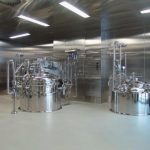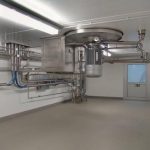Berlin-based P.W. Beyvers GmbH has specialised over the years in the production, testing, filling and packaging of liquid and semi-solid products. In order to be able to produce ethanolic gels under Ex conditions, the company invested in an explosion-proof process plant.
The Beyvers process plant allows cosmetic and pharmaceutical ointments, creams, lotions, gels, etc. from liquid to highly viscous consistency to be produced under hazardous conditions. Both the premises and the process technology were therefore harmonised with Atex regulations for explosion protection. The plant area was divided into three zones:
- Energy (safe area)
- Production (hazardous area)
- Waste water treatment (hazardous area)
The process plant is installed in a false ceiling and consists of a main mixer with a scraper system, a homogenising system and two premix vessels, one with a homogeniser and one with a circulation agitator.
These agitators, specially developed by Vakumix, were given preference over the propeller agitators which are the normal choice for the mixing and melting processes. They offer several benefits: apart from efficient, uniform mixing, the premix can be transferred to the homogenising mixer by means of the agitators. This is also possible if both vessels are under vacuum, which is a special advantage when proces-sing detergent ingredients or during hot/cold processes, as air admission and foaming are avoided. The circulation agitator is installed at the lowest point in the vessel. Thus, even very small batches can be processed. Liquids or powders which are moistened instantly can be conveniently sucked into the circulation flow under vacuum. Moreover, the agitator facilitates short heating and cooling times for the products thanks to the uniform flow on the vessel wall. Due to the high pumping efficiency of the circulation agitator, there is no need for additional pumps for CIP (cleaning in place) on the vessel and all product-contacted piping.
Efficient homogeniser with reserve capacity
In order to be prepared for future products which could need higher shear energies, and in order to avoid maximum loading of the material at all times, priority was given to efficient operation and reserve capacities when selecting the variable-speed homogeniser. The maximum rotor tip speed and the resulting shear rate are the two crucial parameters. The protective rotor of the homogeniser has proved to be particularly useful. Its function is to prevent foreign metal parts from getting into the rotor/stator toothing. These parts could become caught up in the mixer, usually via raw material supplied in bags, and destroy the homogeniser. Due to the special design of this protective device, the pumping efficiency is even higher than with the standard version – an immense benefit with high-viscosity products.
The design of the anchor agitator is critical for good vertical mixing, especially during the cooling and homogenising processes. A stable, homogeneous product is achieved and maintained thanks to constant and clean scraping of the vessel wall by the anchor agitator during the heating and cooling phases.
Plant cleaning according to GMP
In addition to the above-mentioned points, plant cleaning is of particular importance, since it has to be carried out as quickly and reliably as possible. This is guaranteed by the following features:
- High pumping efficiency (= pressure build-up) of the homogeniser
- Easy access to product-contacted seals for cleaning liquids
- Round shape of all installations in the product area
- No screws, pins, etc. in the product area
Due to the separation of the Vakumix premix vessels from the homogenising mixer via an alternating bend station, the premix vessels can be cleaned while the homogenising mixer is still producing. All the vessels are connected together by transfer lines. The process and dosing paths are controlled pneumatically and equipped with signalling devices.
Protection in hazardous areas
In order to verify explosion protection, the whole process was submitted for a safety analysis. The following zones were defined in accordance with the Atex guideline:
- Inside the vessels: Zone 0 (EEx I 2G T3)
- Outside the vessels: Zone 1 (EEx II 2G T3)
- Pipes and fittings: Zone 1 (EEx II 2G T3)
- Vacuum pump arrangement: Zone 1 (EEx II 2G T3)
The safety analysis also included the non-electrical equipment for use in hazardous areas according to DIN EN 13463. The entire production room was consequently lined with conductive stainless steel walls and ceilings, and the plastic flooring fitted with special conductive fibres. The production room was additionally provided with an open-loop controlled ventilation system, which guarantees an explosion-proof exchange of air with a very low germ content. All items of equipment, such as process and plant components, walls, ceilings and floors were earthed. The necessary type examination certificates were obtained from the manufacturers of all bought-in electrical and mechanical parts. An explosion protection officer was appointed by the equipment owner to monitor compliance with Atex requirements.
Since the agitators are in direct contact with the medium and release mechanical energy to the product or the vessel atmosphere during the homogenising and mixing processes, special demands and safety measures relating to the machine functions and the explosion protection had to be considered. It was thus important to keep a close check on ignition sources. The correct installation and protection of each type-tested machine had to be documented and archived. The equipment is only allowed to be used if its material is sufficiently resistant to mechanical and/or chemical influences and corrosion under the relevant operating conditions to prevent any impairment of the explosion protection. Rusty parts, for example, are a potential ignition source. If mechanical seals are used for the agitator, it has to be demonstrated that the temperature rise on the mechanical seal surfaces remains well below the respective ignition temperatures. The necessary monitoring instruments have to meet the requirements of DIN EN 13463–6 and be adjusted according to the defined limits. If the permissible limits are exceeded, the machine is switched off. If mechanical seals are cooled with a sealing liquid, it has to be guaranteed that no chemical reactions and/or dangerous decomposition processes can occur with the product. All vessel installations and conductive plant parts were earthed and connected together. As insulated parts were not allowed to be used, resistant material – especially for O-rings and seals – was employed in this process plant to prevent irreparable damage to or chemical reactions with the product.
cpp 455
More about Vakumix products
Virtual exhibition for mixers, agitators and kneaders
Share:








